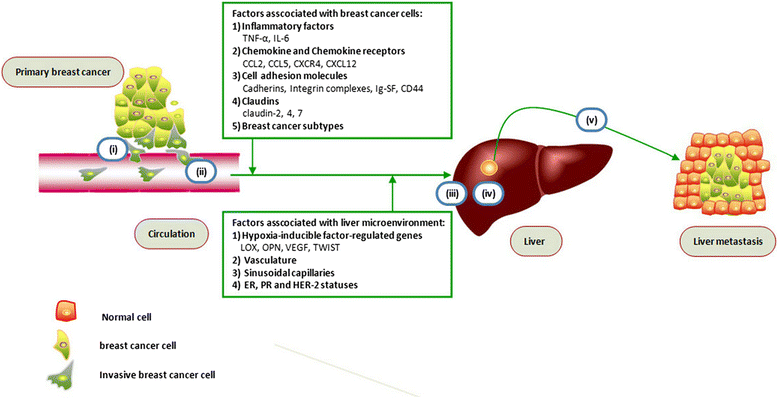Mechanisms involved in breast cancer liver metastasis
- PMID: 25885919
- PMCID: PMC4440291
- DOI: 10.1186/s12967-015-0425-0
Mechanisms involved in breast cancer liver metastasis
Abstract
Liver metastasis is a frequent occurrence in patients with breast cancer; however, the available treatments are limited and ineffective. While liver-specific homing of breast cancer cells is an important feature of metastasis, the formation of liver metastases is not random. Indeed, breast cancer cell factors contribute to the liver microenvironment. Major breakthroughs have been achieved recently in understanding breast cancer liver metastasis (BCLM). The process of liver metastasis consists of multiple steps and involves various factors from breast cancer cells and the liver microenvironment. A further understanding of the roles of breast cancer cells and the liver microenvironment is crucial to guide future work in clinical treatments. In this review we discuss the contribution of breast cancer cells and the liver microenvironment to liver metastasis, with the aim to improve therapeutic efficacy for patients with BCLM.
Figures

References
-
- Jemal A, Center MM, DeSantis C, Ward EM. Global patterns of cancer incidence and mortality rates and trends. Cancer Epidemiol Biomarkers Prev. 2010;19:1893–1907. - PubMed
-
- Perou CM, Sorlie T, Eisen MB, van de Rijn M, Jeffrey SS, Rees CA, et al. Molecular portraits of human breast tumours. Nature. 2000;406:747–752. - PubMed
-
- Siegel R, Naishadham D, Jemal A. Cancer statistics, 2012. CA Cancer J Clin. 2012;62:10–29. - PubMed
-
- Hess KR, Varadhachary GR, Taylor SH, Wei W, Raber MN, Lenzi R, et al. Metastatic patterns in adenocarcinoma. Cancer. 2006;106:1624–1633. - PubMed
Publication types
MeSH terms
Substances
LinkOut - more resources
Full Text Sources
Other Literature Sources
Medical

